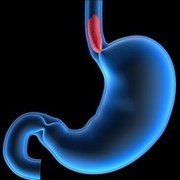 Hemera/Thinkstock
Hemera/Thinkstock
Millions of people experience gastroesophageal reflux disease (GERD) on a regular basis.
When food passes from the esophagus down into the stomach, a ring known as the lower esophageal sphincter opens up to let food in and then closes to keep it in the stomach.
If the ring is weak and does not close tightly, food and stomach acid can come back up into the esophagus, resulting in mucosal changes and symptoms of heartburn.
Here are five facts about GERD you may not know:
1. Diagnosis is often made by symptoms however an endoscopy may also be performed. During an endoscopy, a tube with a camera on the end is passed through the mouth and down the throat in order to best view all the tissue down into the stomach. If warranted, a biopsy may need to be done
2. Extra weight around the middle is considered a real risk factor for those with both GERD and heartburn. A primary treatment is weight loss as it may help avoid taking acid blockers.
3. Eosinophilic esophagitis is being seen more regularly in patients who have GERD. A biopsy of the esophagus will help determine if someone has this disease.
Eosinophilic esophagitis involves an increased number of particular white blood cells known as eosinophils that cause a number of chronic symptoms. Symptoms include difficulty swallowing, sensation or actual choking, coughing, regurgitation, chest pain particularly behind the breast bone and vomiting.
4. Consider the possibility of eliminating foods that may cause allergy from the diet. In eosinophilic esophagitis, the most common food allergies are dairy, gluten, soy, eggs, peanuts, fish/shellfish.
These foods are also the most common food allergies to humans therefore if someone eats a food that causes inflammation, GERD may occur.
These are the foods that people are most commonly allergic to, therefore if someone eats a food that causes inflammation, GERD may occur.
5. Most that have GERD symptoms are on some form of acid blocker, either as needed or daily. In fact, some take them twice a day because their symptoms are so severe.
Unfortunately, long term use of acid blockers can also block the absorption of important minerals such as calcium and magnesium, as well as vitamin B12. These vitamins are critical for bone health, muscles, energy, brain health and more.
If you are experiencing symptoms of heartburn or are looking for different treatments to help your upper gastrointestinal problems, talk with your health care provider about options, and consider taking out those common food allergens for six weeks and see how you feel.
References:
1. Reuters. (2013). New Guidelines for Diagnosis and Management of GERD. Web. 17 March, 2013.
http://www.medscape.com/viewarticle/780737
2. Johnson, D. (2012). The Food-Elimination Diet in Adult Eosinophilic Esophagitis. Web. 17 March, 2013.
http://www.medscape.com/viewarticle/768563
3. Cochran Upper Gastrointestinal and Pancreatic Diseases Group. (2012). Medical Treatments for Eosinophilic Esophagitis (a chronic disease associated with increased numbers of eosinophils in the esophagus and symptoms of esophagitis). Web. 17 March, 2013.
http://www.ncbi.nlm.nih.gov/pubmedhealth/PMH0012515
4. The Harvard Medical School Family Health Guide. (2006). Do PPIs Have Long Term Side Effects. Web. 17 March, 2013.
http://www.health.harvard.edu/fhg/updates/do-ppis-have-long-term-side-effects.shtml
Reviewed March 18, 2013
by Michele Blacksberg RN
Edited by Jody Smith



